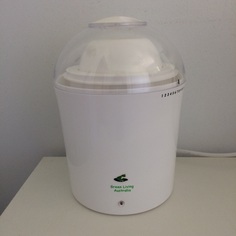
They say that the best way to get over getting bucked off a horse is to get right back on, so since that devastating moment I’ve tried pretty much every brand of vegan yogurt that I can buy. And while some have been pretty good (thank you coconut yogurt) they are generally rather underwhelming.
Our journey into making vegan yogurt has so far been paved with coconut cream and we have left behind us the ghosts of failed batches, though their memory lingers on. But fear not, gentle reader, for you can learn from our mistakes and hopefully in no time you too will be whipping up beautiful batches of dairy free yogurt.
So let’s get started… Put two cans of coconut milk and two tablespoons of sugar in a pan and heat. Add two tablespoons of tapioca starch that you have mixed into a paste with some water to the coconut milk and stir, simmering until the mixture thickens. Set aside to cool. While the mixture cools, clean your thermos well with hot soapy water and then fill with boiling water and allow to sit for several minutes. Empty and allow to dry. Try not to touch it with your fingers – the aim is to cultivate lots of good bacteria, not lots of the ones that make you sick.
When your coconut milk mixture is between 37 and 42 degrees add to it EITHER one quarter cup of yogurt / quarter teaspoon of good quality yogurt starter / three high quality probiotic capsules (the sort you have to keep in the fridge). Stir and pour into the thermos. Wrap the thermos is a teatowel or two to keep it warm for as long as possible and leave somewhere warm for 12 hours. And voila! You now have yogurt!
Once you get the hang of it you can make yogurt out of any non-dairy milk. The two main issues here are thickening and the starter culture. You can thicken your yogurt a variety of ways and it’s best to experiment to find the way that’s right for you. Pectin, agar-agar and tapioca starch will all work and the process is the same for all three – so it’s up to you how you proceed. If you don’t thicken your yogurt it will be perfect for smoothies and just as good for you – just runnier.
The longer the incubation period the thicker your yogurt will be but it’s hard to find a thermos that will maintain temperature for more than twelve hours. A yogurt maker is (unsurprisingly) perfect for the job and other people have had success with slow cookers on the lowest settings (it has to be between 37 and 42 degrees) or even an oven on the lowest setting. The bacteria that create the yogurt won’t survive at hotter than 42 degrees so it’s worth being pretty careful about your heat source otherwise you’ll end up with a sort of overcooked rice pudding sans the rice.
Once you’ve made yogurt it will keep in the fridge for several days. Good luck!

 RSS Feed
RSS Feed
